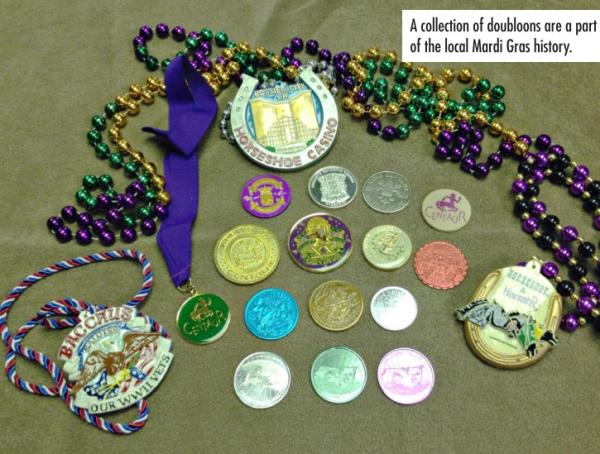
Local man collects Mardi Gras history
Mardi Gras throws are one of the most popular draws of the carnival season. Float-riders have been tossing trinkets ranging from glass beads to coconuts to crowds for the past hundred years, but doubloons are a more recent addition to the parade scene.
Leonard Gresens, a collector in Shreveport, said H. Alvin Sharpe is credited with the idea of throwing aluminum coins, having pitched the idea to the Captain of Rex in 1959.
“The King of Rex wanted something new to throw. When he expressed his concern about the safety of throwing coins to the crowd, Sharpe reportedly stood 10 feet away from the captain and pelted him with handfuls of coins and they were deemed safe to throw,” Gresens said.
The other krewes followed suit and today, doubloon collecting is a popular pastime in New Orleans. “It’s a big deal down there,” Gresens said. “I’m in one of the collecting groups there, and people fight over these things.”
The most common Mardi Gras doubloons are brightly colored anodized aluminum coins about the size of a silver dollar. Many doubloons have the symbol of the krewe and the date it was organized on the front. The back usually has the theme of that year’s parade.
“Aluminum was affordable and cheap to produce,” Gresens said. “Later they went to the heavier metals, like bronze, silver and gold. Those were more keepsakes. They weren’t thrown. There are rarer because less were made and they are harder to come by.”
Some advertising doubloons in New Orleans have a press release. “Popeye’s Fried Chicken did one,” Gresens said. “Pat O’Brien’s did one. Advertisers would have a special doubloon that you could turn in for something free. I collect the Popeye’s ones from New Orleans because I just love Popeye’s.”
With Mardi Gras doubloons firmly established and widely collected in South Louisiana, Gresens would like to see the collectors’ market grow in North Louisiana, as well.
“A lot of it has to do with the history,” he said. “They are going to be different every year. Nowadays they have all of the colors, too, in red and green and purple. Now royalty is doing their own with their names on them. So there are all kinds of different doubloons to collect.”
“One year, Centaur did 20-30 types in one year, with the queen, the king, the captain, the duchesses,” Gresen said. “Now, they have diminished down to where they aren’t doing as many because they have gotten more expensive to produce.”
Advertising doubloons were also released in North Louisiana. “One year in Shreveport, the Chevy guys released a doubloon,” Gresens said. “It was actually a smaller one, and if you caught one and brought it in you got $500 off your car. Circle K did a couple of them here for a free loaf of bread or a free Icee. The casinos here used to do them, too, for a free gift or a free pull. Those are rare because they were typically turned in, but there are still some of them out there.”
It’s hard to say what makes one doubloon or set more worthy of coveting, but Gresens does have some on his list. “Gemini issued some one year that weren’t thrown,” he said. “They were only handed out to people in the krewe. I don’t even have that set. That’s something I’m looking for, and I keep my eye out for and there are some other special type issues.”
Although
many price guides have been released, the most comprehensive was last
released in 2002, “Doubloons, Commemorative Medals,” by Bayou Products.
The only guide currently being produced, “Crescent City Doubloon
Traders,” only features doubloons from New Orleans krewes.
“We
run into so many varieties in North Louisiana,” Gresens said. “My
friend Jonathan Fox and I have been trying to put together a traders’
guide. Every time we find something new, we have to update it. He gets
the kids in his classes at school to bring in doubloons. Just recently,
he had one come in that we didn’t have. So every now and then, a
different color or variety will surface.”
Good
places to look for collectible doubloons are area antique stores, yard
sales and estate sales. “You can find them on eBay every now and then,
but some people think they’re worth a lot of money there,” Gresens said.
Pricing is sketchy. “The aluminums won’t cost a lot,” Gresens said. “The bronze or ionized silver are probably in the $5 range.
Most
of the silver ones are .999 silver, one ounce, so they’ll be at least
$14, but that’s the melt value. You’ll probably pay a premium for those.
I know I have. Even the krewes sell them for $25 or $30.”
Storing
and displaying them is also an issue. “I’ve got mine in year to date
order in two-by-two pages in binders so I can find them when I need to
look up one,” Gresens said. “I also put them in plastic cases but I’ve
seen them under glass. I’ve seen them framed a number of different ways,
but I think the best way if you’re going to trade them is to put them
in chronologic order in a binder.”
“I’d really just like to see more people get interested in collecting in North Louisiana,” Gresens said.
“The
Crescent City Doubloon Club in New Orleans has different swaps where
people trade. I know there are collectors up here and I would love to
get together with them and start a group.”
–Susan Reeks
Learn more:
For more information about collectible doubloons, go to www.facebook.com/Doubloons or contact Leonard Gresens at 272-2190.